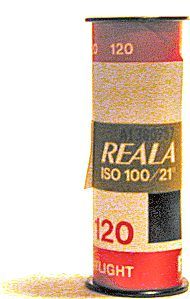120 film
|
|
120 is a film format for still photography introduced by Kodak for their Brownie No. 2 in 1901, and still very popular, as the surviving medium format.
The 120 film allows several image formats, the most common being the 6 × 6 cm (120 square format), or more exactly 56 × 56 mm. Rectangular formats 6 × 9 cm (120 full-frame format) and 6 × 4.5 cm (120 half-frame format) are also standard. Additionally 6 × 7 cm, and even 6 × 8 cm are used. Special-purpose panoramic cameras even produce 6 × 12 or 6 × 17 cm exposures. Like 6 × 6, all sizes are nominal; actual dimensions are a bit smaller, and in fact, 6 × 7 enlarges exactly (without wasting any film) to 8 × 10 paper, for which reason its proponents call it the "ideal format."
The 120 is a typical roll film format. The bobbin was originally made of wood with metal flanges, later all metal, and finally plastic. Frame number markings for the three standard image formats are printed on the backing paper.
There are 12 exposures per film when using 6 × 6 format, 16 or 15 for 6 × 4.5, 10 for 6 × 7, 9 for 6 × 8 and 8 for 6 × 9. The film is 72 cm long.
The term 645 format is often used now as reference to an ordinary 120 or 220 film used in the 6 × 4.5 cm image format. Due to better control of frame space, modern 645 format cameras get 16 exposures per roll of 120.
The 120 format was originally intended for amateur photography. It was later superceeded in this role by 135 film, and became a format for professional use.
220, introduced in 1965, is the same format as 120, but with double length (144 cm) film and thus twice the number of exposures per roll. Unlike the 120, there is no backing paper behind the film itself, just a leader and a trailer. This results in a longer film on the same spool, but as a result, there are no printed frame numbers, and moreover, it cannot be used in unmodified old cameras that have the red window as frame indicator. Also, since the film alone is thinner than a film with a backing paper, depending on camera type a special pressure plate may be required to achieve optimal focus. Some camera capable of using both 120 and 220 film will have a two position adjustment of the pressure plate while others will require different film backs.
The 620, introduced by Kodak in 1931 as an intended alternative to the 120, is essentially the same film on a sligtly different all metal bobbin (120 was wood cored at that time):
- 120 2.466" length, 0.990" flange, 0.468" core
- 620 2.468" length, 0.905" flange, 0.280" core
620 film was discontinued in 1995, but some photographers respool 120 film on 620 bobbin in the darkroom to use their 620 cameras.
The 105, introduced by Kodak in 1898 for their first folding camera, was the original 6 × 9 cm format roll film. The 117, introduced by Kodak in 1900 for their first Brownie camera, was 6 × 6 cm format. These formats used the same width film as the 120, but with slightly different bobbins.sv:120-film

